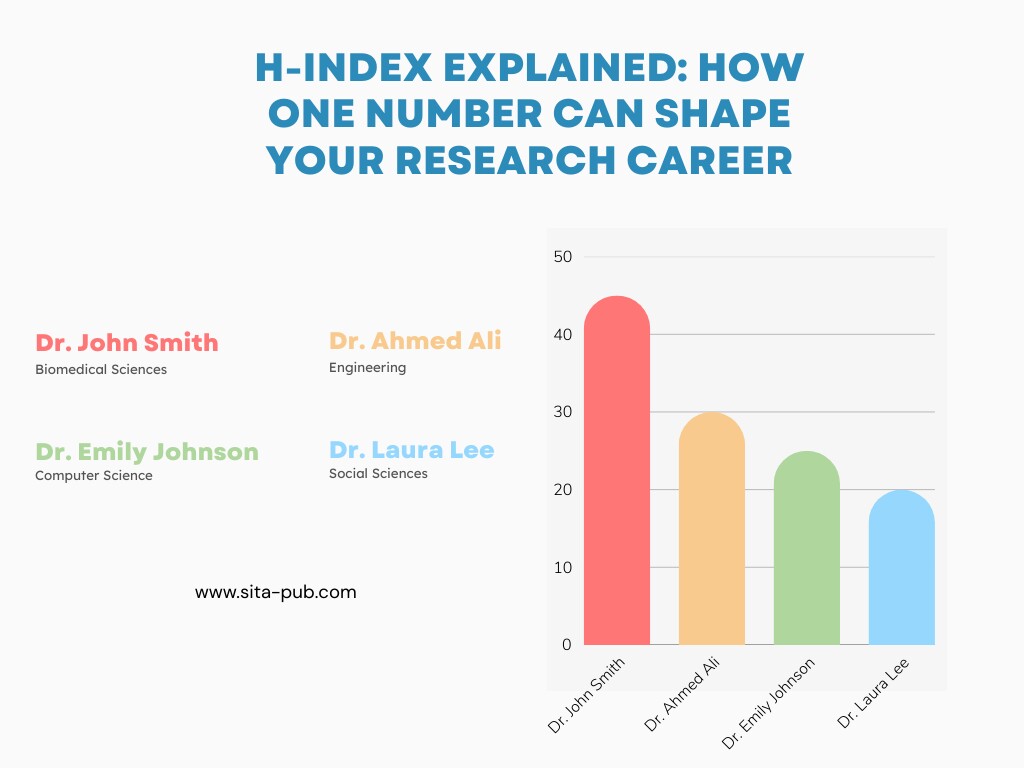h-Index Explained: How One Number Can Shape Your Research Career


In the ever-expanding world of academic publishing, researchers are constantly measured by the impact of their work. Among the various metrics available, the h-index has gained widespread recognition as a standard indicator of a researcher's productivity and influence. But what exactly is the h-index, and how much does it really tell us?
Let’s break it down.
The h-index was proposed by Jorge E. Hirsch, a physicist, in 2005 as a way to quantify both the productivity and citation impact of a researcher's publications. The idea was to create a single number that reflects not just how many papers a person has published, but how often those papers are cited by others.
A researcher has an h-index of “h” if they have h papers each cited at least h times.
For example, an h-index of 8 means the researcher has 8 papers that have each been cited at least 8 times.
This metric quickly gained popularity because it combines quantity and impact into a single, easy-to-interpret figure.

Balances quality and quantity: It discourages mass-publishing low-impact papers and rewards consistent, citable research.
Field-agnostic (to a degree): Can be used across disciplines, though with some caveats (see below).
Simple to understand and widely used in hiring, tenure, and funding decisions.
Biased by career length: Early-career researchers may have a low h-index despite strong work.
Ignores author position: A first-author paper and a last-author paper are treated the same.
Field variations: Citation behaviors differ across fields (e.g., physics vs. humanities), making comparisons across disciplines tricky.
Does not reflect recent impact: It does not show whether recent papers are gaining attention.
Academic Field | Typical h-Index for Mid-Career Researcher | Typical h-Index for Senior Researcher | Reasons for Variation |
Physical and Life Sciences | 20-40 | 50+ | High citation rates due to large volume of publications and significant impact of research. |
Biomedical and Clinical Sciences | 25-45 | 50+ | High citation counts due to relevance to health, societal impact, and clinical applications. |
Engineering and Technology | 15-30 | 40+ | More specialized topics with fewer but impactful publications. |
Social Sciences | 10-20 | 20-35 | Slower citation rates and more qualitative research. |
Humanities | 5-15 | 10-20 | Lower citation rates, less frequent citation of publications. |
Citation Practices: Fields like biomedical sciences and physical sciences tend to generate more citations due to the practical application and societal relevance of the research, leading to higher h-index values.
Publication Frequency: Disciplines with frequent publication cycles, like the life sciences, generally have higher h-indexes due to the volume of work.
Specialization and Collaboration: In engineering, technology, and social sciences, research tends to be more specialized or qualitative, which leads to a lower citation count per paper and, in turn, a lower h-index.

List all your published papers.
Order them by the number of citations, from most to least.
Find the point at which the number of citations is equal to or greater than the paper’s rank number.
Example: If your 5th paper has at least 5 citations, and the 6th has fewer than 6, your h-index is 5.

Google Scholar – Most user-friendly; shows h-index on your profile.
Scopus – Offers a field-normalized h-index and journal metrics.
Web of Science (Clarivate) – Provides a more conservative but curated h-index.
Publish or Perish (PoP) – A desktop application that pulls citation data and calculates h-index from multiple sources.
There's no universal benchmark, but here are some general guidelines:
Career Stage | Typical h-Index |
PhD Student | 0–5 |
Early-career (postdoc) | 5–15 |
Mid-career Faculty | 15–30 |
Senior Professor | 30+ |
These numbers vary by discipline. For example, biomedical sciences tend to have higher citation rates than engineering or social sciences.

The h-index matters—but it’s not everything.
Institutions often use it in evaluating promotion and funding applications. It can reflect how influential your work is in the academic community. However, it shouldn't be the only indicator of a researcher's worth or contribution.
Innovative, interdisciplinary, or applied research may not always score high in citation metrics, yet can have huge real-world impact.
The h-index is just one of many ways to evaluate academic performance. Here are a few others:
i10-index: Number of publications with at least 10 citations (Google Scholar).
g-index: Gives more weight to highly cited papers.
Altmetrics: Measures social media attention, downloads, and other online engagement.
Citation count: Total number of citations received.
Field-Weighted Citation Impact (FWCI): Normalizes citation impact across disciplines.
Journal Impact Factor (JIF): Reflects the average citations of articles in a journal—more useful for journals than individuals.
The h-index is a useful but imperfect tool. It provides a quick snapshot of a researcher's impact, but it should always be considered alongside qualitative evaluations, peer reviews, and other contextual factors.
Whether you’re applying for a fellowship, preparing a promotion file, or just tracking your progress—it’s good to understand how the h-index works and where it fits into the bigger picture of research metrics.
If you have any questions, inquiries, or would like to learn more about our services, please don't hesitate to reach out to us. Our dedicated team is ready to assist you.